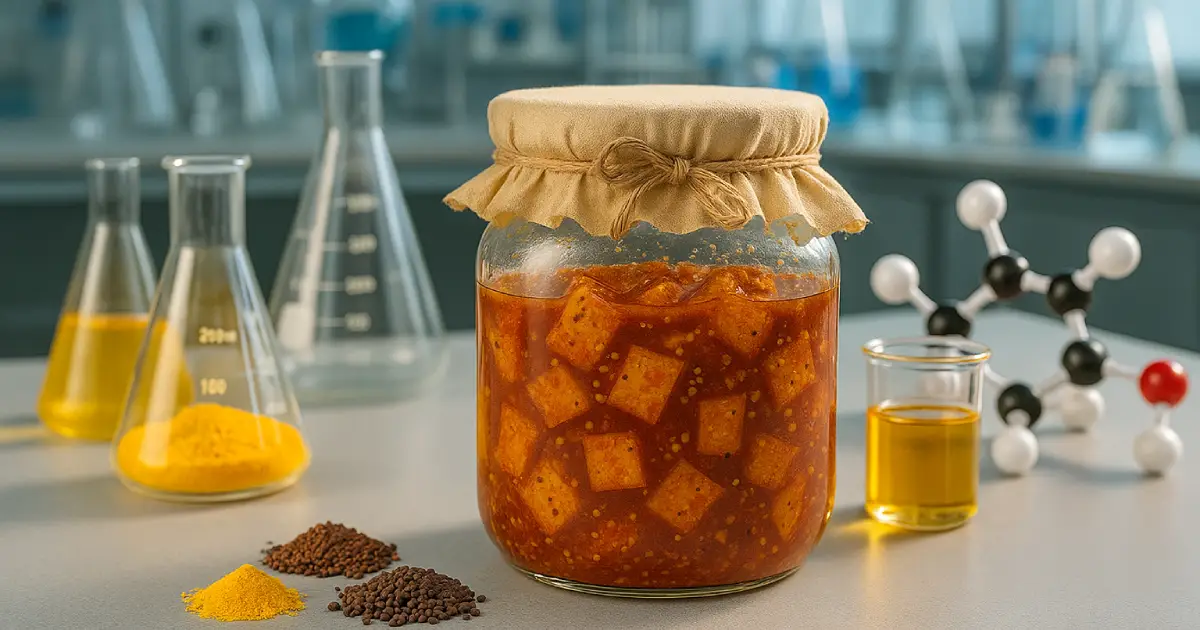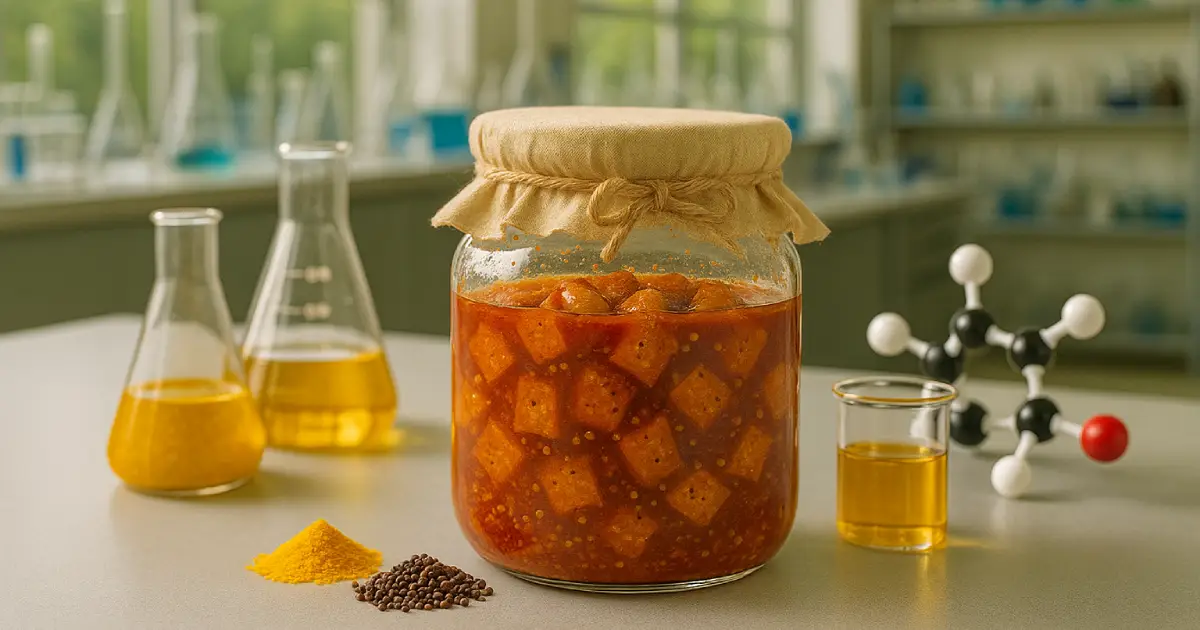- Your cart is empty
- Continue Shopping

The Chemistry of Homemade Achar: What Really Happens When Spices, Oil, and Sunlight Meet.
Pickles, or Homemade Achar as they are lovingly called across India, are more than just culinary treasures. They’re also living laboratories of chemistry, where spices, oil, salt, and sunlight work together to transform raw fruits and vegetables into complex, flavorful, and long-lasting condiments. To most people, achar is about taste and tradition, but beneath the tangy kick lies a symphony of chemical reactions—preservation, oxidation, enzymatic activity, and photochemistry—all harnessed in an age-old art.
Salt: The First Line of Chemistry.
The journey begins with salt, the simplest yet most powerful preservative. When raw mango, lime, or chili meets salt, osmosis kicks in. Salt draws out water from plant tissues, reducing the moisture content that microbes need to survive. This process creates a hypertonic environment where harmful bacteria and fungi struggle to grow. At the molecular level, sodium and chloride ions disrupt microbial enzyme systems, slowing down spoilage. The salty brine that forms isn’t just protective—it becomes a medium in which other chemical reactions unfold.
Oil: A Molecular Blanket.
In Indian Homemade Achar, oil—often mustard or sesame oil—does much more than add richness. It acts as a hydrophobic layer, cutting off oxygen from reaching the submerged fruits and spices. By reducing exposure to oxygen, oil slows down oxidative rancidity and microbial growth. Chemically, mustard oil contains allyl isothiocyanate, a compound that has antimicrobial properties. This means the oil itself becomes part of the preservative system. Over time, as spices release their essential oils, the cooking medium turns into a protective, aromatic solvent that stabilizes volatile compounds.
Spices: Natural Biochemistry at Work.
The heart of achar lies in its spice blend, each contributing unique chemical compounds:
- Turmeric: Contains curcumin, a polyphenol with strong antioxidant and antimicrobial effects. It slows oxidative spoilage and adds that golden hue.
- Fenugreek: Rich in saponins and alkaloids, it stabilizes flavor and improves shelf life.
- Chili: Capsaicin not only provides heat but also inhibits fungal growth.
- Mustard seeds: Release isothiocyanates when crushed, compounds known for their pungency and preservative action.
- Garlic and ginger: Contain sulfur compounds like allicin, powerful antimicrobials that suppress unwanted bacterial activity.
Together, these spices create a biochemical shield that makes achar shelf-stable without synthetic preservatives.
Acid: The Tang of Safety.
Fermented pickles rely on lactic acid bacteria, but in sun-cured Indian achar, acids mostly come from the ingredients themselves—citrus fruits, tamarind, or vinegar in some recipes. Acidity lowers the pH, creating conditions in which pathogenic bacteria cannot thrive. At the molecular level, acids denature microbial enzymes, reducing their ability to function. The sourness we enjoy is actually the taste of microbial suppression at work.
Sunlight: The Unseen Catalyst of Homemade Achar.
Traditional achar-making often calls for leaving jars in direct sunlight for days or even weeks. To an outsider, this may seem like superstition, but sunlight is an elegant chemical tool. Ultraviolet (UV) light helps sterilize surfaces by damaging microbial DNA. Gentle heating by the sun also speeds up diffusion: essential oils from spices move faster into the fruits, while acids and salts penetrate cellular walls more deeply. In effect, sunlight accelerates extraction and infusion, creating the intense flavor profile that defines achar.
Photochemistry also alters certain compounds. For instance, curcumin in turmeric undergoes light-assisted stabilization, and chlorophyll in green chilies can degrade into pheophytins, slightly changing color while still maintaining edibility. Far from being de structive, sunlight carefully managed becomes a controlled catalyst of maturation.

Oxidation and Controlled Aging of Homemade Achar
Despite oil’s protection, some slow oxidation still occurs, and this is not entirely bad. Small-scale lipid oxidation from mustard oil contributes to the earthy flavor that develops over weeks. Polyphenols from spices scavenge free radicals, preventing rancidity from going too far. This balance between oxidation and antioxidant defense creates depth in taste, akin to how wine ages.
Microbial Checkpoints
Not all microbes are enemies. Trace levels of lactic acid bacteria sometimes sneak in, particularly in vegetable Homemade Achar. These bacteria convert sugars into lactic acid, further lowering pH and contributing to tang. What emerges is a self-regulating system: salt and oil slow harmful microbes, while beneficial ones, if present, enhance flavor and safety.
The Science of Shelf Life of Homemade Achar
Why can a properly made achar last for months or even years? It’s because several layers of chemistry work together:
- Salt reduces water activity.
- Oil blocks oxygen.
- Spices contribute antimicrobials.
- Acids create an unfavorable pH.
- Sunlight sterilizes and infuses.
This multi-barrier approach is a classic food preservation technique, developed long before the science was formally understood.
A Molecular Symphony in Every Bite
When you bite into a piece of sun-cured mango achar, you’re tasting more than spice. You’re experiencing osmosis-driven dehydration, curcumin-stabilized antioxidants, isothiocyanate-driven pungency, lipid oxidation balance, and light-mediated flavor infusion. The tang, heat, and aroma are all chemical signatures layered over time. The jar on your shelf is not static; it’s a living chemistry set, evolving slowly as molecules dance, interact, and transform.
Read This Now – The Psychology of Achar Cravings: Why Spicy-Sour Comforts Us

1 Comment